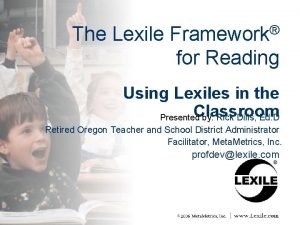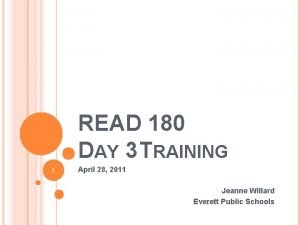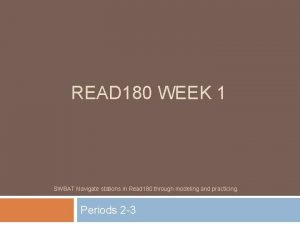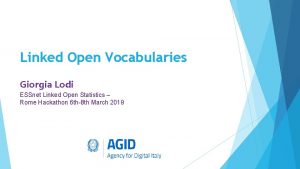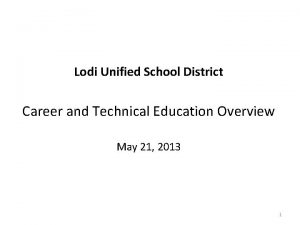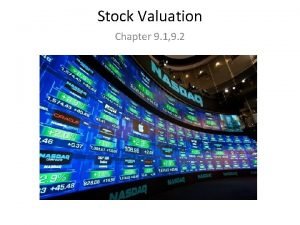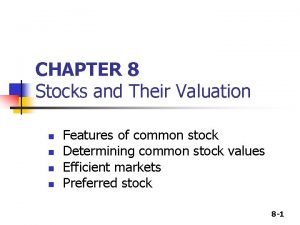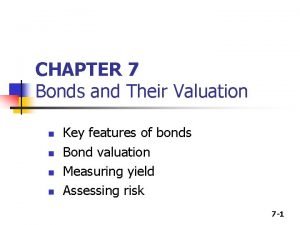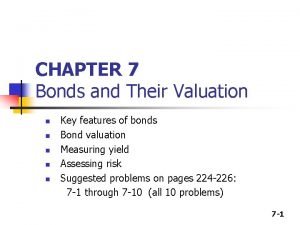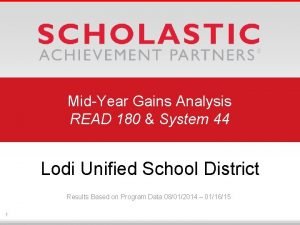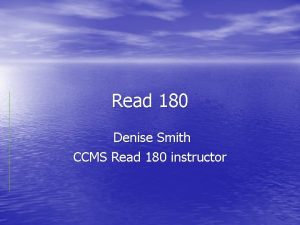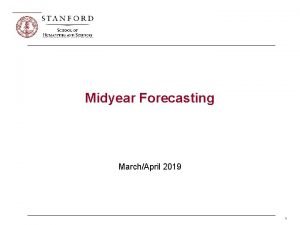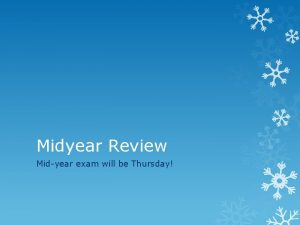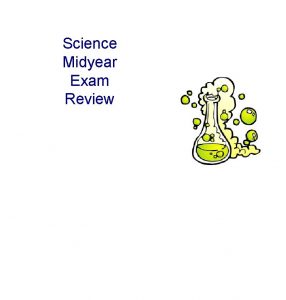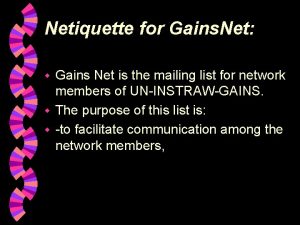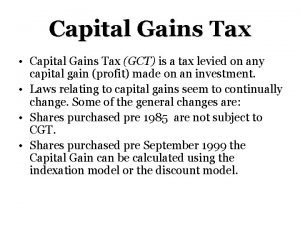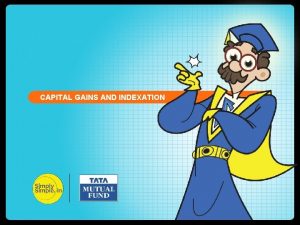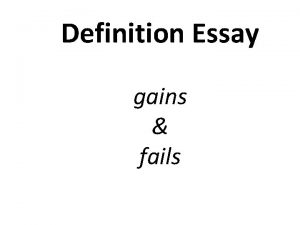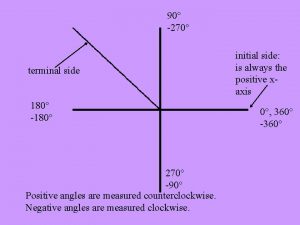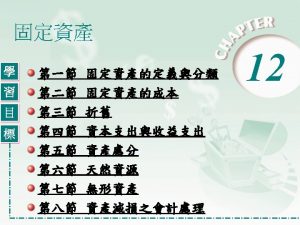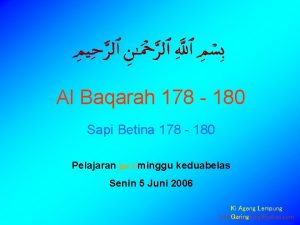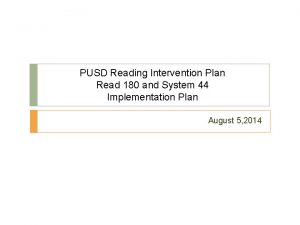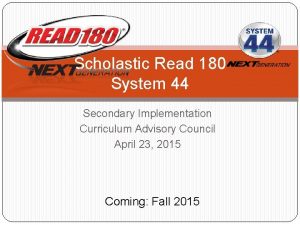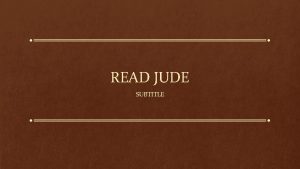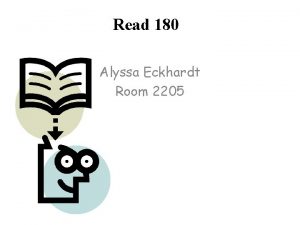MidYear Gains Analysis READ 180 System 44 Lodi





























- Slides: 29

Mid-Year Gains Analysis READ 180 & System 44 Lodi Unified School District Results Based on Program Data 08/01/2014 – 01/16/15 1

Executive Summary In partnership with the district, Scholastic has analyzed data from implementations at 36 sites that have used READ 180 & System 44 reading intervention programs this school year. Preliminary Analysis Observations • Data were analyzed for 1, 390 READ 180 and 1, 849 System 44 enrolled students -- producing 996 READ 180 and 1, 050 System 44 records for gains analysis. • At time of export, 70 students were enrolled in both READ 180 & System 44 with sessions on one or both programs; these students are counted in one data set only based upon majority software usage (45 System 44 & 25 READ 180). • Mid-year February data export indicates evidence of strong growth with strong software use in READ 180 and System 44. Scholastic Data Services 2

Summary SRI Growth Metrics READ 180 Sample 100% 80% 60% 40% 20% 0% 79% System 44 Sample 70% 37% 18% Improved SRI Lexile Total Students in SRI Sample Exceeding Annual Growth Goal 13% 2% Met 2 x Annual Growth Goal 996 Students w/ SRI 16% 9% Improved SRI CC Performance Level 1478 Students w/ SRI Above reflects students with 2 Scholastic Reading Inventory test administrations at least 8 weeks apart with 10 or more software sessions; System 44 students total does not reflect the complete students with 2 SPI used in subsequent slides but comes from the same data. Scholastic Data Services 3

Summary Usage Dashboard Software Sessions 56 System 44 60 READ 180 Minutes per Session 25 Mid-Year Ideal = 50+ (Daily, 90 Minute Model) & 20 -30 w/ A-B Schedule (2 -3 sessions per week) 20 HIGH 17 GOOD 15 10 LOW 5 0 0 16 READ 180 System 44 Software Content Units 8 System 44 Series Mid-Year Ideal = 5 to 6 End of Year Ideal = 10 to 12 (Daily Model) or 5+ (A-B Schedule) 10 READ 180 Segments 0 5 10 12 Scholastic Data Services 15 20 25 4

READ 180 Results Scholastic Data Services 5

READ 180 Super Stars Data indicate 343 READ 180 Super Stars with evidence of both strong participation and Lexile Gains. The students with the most growth relative to expectations are displayed above. To reach “Reading Super Star” status, students must have: • At least 20 sessions (days) of software usage • At least 1 Segment completed in the READ 180 software • An annual growth rate between 1. 0 and 4. 0 • Pre-Test SRI Lexile score of over 100 L. Scholastic Data Services 6

READ 180 Super Stars By School Elementary Schools Percentage Middle Schools Percentage Clairmont 100% Henderson 45% Lockeford 50% Delta Sierra 44% Beckman 42% Houston 40% Washington 33% Millswood 37% Lawrence 33% Christa Mc. Auliffe 35% Oakwood 31% Lodi 33% Creekside 25% Morada 30% Sutherland 23% Ansel Adams 22% High Schools Percentage Mosher 20% Lodi 43% Borchardt 20% Bear Creek 38% Wagner Holt 17% Plaza Robles 36% Mc. Nair 32% Liberty 29% Tokay 25% 7

READ 180 Mean Lexile Gains by Site Elementary Schools Students included in this analysis completed at least two SRI tests a minimum of 8 weeks apart. Review the SRI Growth Summary Report for more information. Analysis Note: “Red Bars” report does not reflect sites with fewer than 10 students. 10 sites contained fewer than 10 students. See slide #15 Scholastic Data Services 8

READ 180 Mean Lexile Gains by Site Middle Schools Students included in this analysis completed at least two SRI tests a minimum of 8 weeks apart. Review the SRI Growth Summary Report for more information. Scholastic Data Services 9

READ 180 Mean Lexile Gains by Site High Schools Students included in this analysis completed at least two SRI tests a minimum of 8 weeks apart. Review the SRI Growth Summary Report for more information. Analysis Note: “Red Bars” report does not include Liberty High School as this site contained fewer than 10 students Scholastic Data Services 10

System 44 Results Scholastic Data Services 11

System 44 Student Progress and Software Use Overview All Students Minimum Progress Goal per Year Lexile Growth Zone The chart above indicates the range of content completion for System 44 students. A student’s goal is to complete all 25 Series; students should strive to complete at least 10 Series in a year. Scholastic Data Services 12

System 44 Student SPI Results – Total Students by Decoding Level Analysis Note: Above data reflects ONLY those students with sufficient software usage and SPI test administrations to meet the “Gains Analysis Sample” criteria. Scholastic Data Services 13

System 44 SPI and SRI Test Results Review System 44 Growth Measures 100% 80% 74% 70% 60% 45% 40% 0% 18% 16% 20% SPI: Improved Accuracy SPI: Had Fluency Growth of 4+ Points SPI: Advancing Decoder 1, 050 students with 2+ SPI SRI: Improved Lexile SRI: Exceeded Score Annual Growth Goal 1, 478 students with 2+ SRI Above data indicate that foundational reading skills are improving; foundational skills affect reading comprehension scores like Lexiles. Meeting Lexile annual growth goal is more likely after A) Students complete Series 20 to 25, B) Students demonstrate Advancing Decoder Status on SPI. Analysis Note: Above data reflects ONLY those students with sufficient software usage and SPI &/or SRI test administrations to meet the “Gains Analysis Sample” criteria of 8+ weeks between pre and post-test administration. Scholastic Data Services 14

Lodi Unified School District Results Based on Program Data 08/01/2014 – 02/19/2015 Scholastic Data Services 15

Executive Summary In partnership with the district i. Read reading instructional program’s data has been analyzed from implementation at 8 sites across the district. Preliminary Analysis Observations • Students’ data were analyzed 1, 754 i. Read students Grades Kindergarten – 3 rd with complete i. Read screeners & software use. • Mid-year January data export indicates evidence of progress with i. Read software: students are averaging 38 completed sessions at 23 minutes in length. • 424 i. Read students have progressed out of their initial content level. Scholastic Data Services 16

i. Read Foundational Reading Skills – Initial Student Placement Above indicates how many students were placed in each of the 15 content Units of i. Read, with grade level equivalencies and Unit content description indicated for reference. Scholastic Data Services 17

Kindergarten i. Read Students’ Topic Completion as a Measure of Progress Level B (1 st Level B Topics 104 to 215 Grade Content) Level A Topics 1 to 103 • • Above indicates how student groups in i. Read have progressed from their initial level of content mastery to a higher level of understanding. By demonstrating fluency in each Topic’s built-in assessment of skills, students demonstrate increases in foundational reading skills. Scholastic Data Services 18

1 st Grade i. Read Students’ Topic Completion as a Measure of Progress Level C Topics 216 to 310 Level C (2 nd Grade Content) Level B (1 st Grade Content) Level B Topics 104 to 215 Level A Topics 1 to 103 • • Above indicates how student groups in i. Read have progressed from their initial level of content mastery to a higher level of understanding. By demonstrating fluency in each Topic’s built-in assessment of skills, students demonstrate increases in foundational reading skills. Scholastic Data Services 19

2 nd Grade i. Read Students’ Topic Completion as a Measure of Progress Level C Topics 216 to 310 Level C (2 nd Grade Content) Level B (1 st Grade Content) Level B Topics 104 to 215 Level A Topics 1 to 103 • • Above indicates how student groups in i. Read have progressed from their initial level of content mastery to a higher level of understanding. By demonstrating fluency in each Topic’s built-in assessment of skills, students demonstrate increases in foundational reading skills. Scholastic Data Services 20

i. Read Student Progression Through Foundational Reading Skills Above indicates how many students are in each of the 15 content Units of i. Read, with grade level equivalencies and Unit content description indicated for reference. Scholastic Data Services 21

Appendix 22

System 44 Student Progress and Software Use Overview 3 rd Grade Students Minimum Progress Goal per Year Lexile Growth Zone The chart above indicates the range of content completion for System 44 3 rd grade students. Scholastic Data Services 23

System 44 Student Progress and Software Use Overview Grades 4 -6: SPED Students Minimum Progress Goal per Year Lexile Growth Zone The chart above indicates the range of content completion for System 44 grades 4 -6 SPED students. . Scholastic Data Services 24

System 44 Student Progress and Software Use Overview Remainder: Excluding 3 rd and Grades 4 -6 SPED Minimum Progress Goal per Year Lexile Growth Zone The chart above indicates the range of content completion for System 44 stuents excluding Grade 3 and Grades 4 -6 SPED students. Scholastic Data Services 25

Key to Understanding i. Read Content and Grade Level Equivalence 310 Topics 51 Series 15 Units Topic Series Unit Level 3 Levels Basic concept(s) in a selfcontained Lesson with builtin assessment. Family of Topics that fit together with a summative assessment. Series each have 5 to 7 Topics. Family of Series that fit together as a content unit. Units each have 1 to 8 Series. Units fit together to cover the foundational literacy skills that are aligned to each grade level (K-2). Level A = Units 1 -4, Level B = Units 5 -11 & Level C = Units 12 -15 Scholastic Data Services 26

Implementation Model Affects READ 180 Usage Metrics Metric Mid-Year @ 45 -50 Minutes per Day (Daily) Days (Sessions) Sessions per Week Minutes per Session Segments Mid-Year @ 90 Minutes per Day (Daily) End of Year @ 45 -50 Minutes per Day (Daily) ~30 2 to 3 ~50 3 to 5 60+ 2 to 3 100+ 3 to 5 16 to 20 3 5 6 10 * ~45 minutes per day assumes that half a 90 minute model occurs on day 1 then the second half on day 2. Whole Group (20 Min) End of Year @ 90 Minutes per Day (Daily) READ 180 Software Independent Reading Wrap Up (10 Min) Small Group Instruction Scholastic Data Services 27

Lexile Annual Growth Goals Using Student’s Fall SRI Performance & Grade Level to Set Goals for Students • SRI can be used to set reading goals and to compare students’ response to instruction to growth expectations from fall to spring. • Monitoring growth helps educators to determine if students are on track to meet achievement standards. • Expected growth can be determined by fall SRI Lexile and grade level; for more on using fall Lexiles to set growth goals consult the professional paper Growth Expectations – Setting Achievable Goals • Tier III reading intervention students are unlikely to reach personal growth goals without a firm grasp of phonemic principles. • Scholastic recommends that System 44 students receive 3 Scholastic Phonics Inventory (SPI) Tests to monitor emerging skills. • Without knowledge of a student beyond data in the export, Gains Analysts simply assign student records with personal Lexile growth goals derived from tables similar to the one at the right. Scholastic Data Services 28

2015 Scholastic SRI College and Career Lexile Proficiency Bands Grade Below Basic Proficient Advanced K N/A BR 0 to 279 L 280 & Above 1 BR 0 L to 189 L 190 L to 534 L 535 L & Above 2 BR to 219 L 220 L to 419 L 420 L to 654 L 655 L& Above 3 BR to 329 L 330 L to 519 L 520 L to 824 L 825 L& Above 4 BR to 539 L 540 L to 739 L 740 L to 944 L 945 L& Above 5 BR to 619 L 620 L to 829 L 830 L to 1014 L 1015 L & Above 6 BR to 729 L 730 L to 924 L 925 L to 1074 L 1075 L & Above 7 BR to 769 L 770 L to 969 L 970 L to 1124 L 1125 L & Above 8 BR to 789 L 790 L to 1009 L 1010 L to 1189 L 1190 L & Above 9 BR to 849 L 850 L to 1049 L 1050 L to 1264 L 1265 L & Above 10 BR to 889 L 890 L to 1079 L 1080 L to 1339 L 1340 L & Above 11 / 12 BR to 984 L 985 L to 1184 L 1185 L to 1389 L 1390 L & Above With the release of SRI College & Career, Scholastic has updated the performance levels (the score ranges that indicate Below Basic, Proficient, and Advanced performance in each grade) to reflect increased expectations for college and career readiness. This work was done with Meta Metrics, Scholastic’s measurement partner and creator of the Lexile Framework. To establish the new performance levels, Meta Metrics conducted an extensive study of college and career texts. The new score ranges more accurately reflect whether students are on track to comprehend college and career level texts by the end of high school. Scholastic Data Services 29
 Reading inventory score chart
Reading inventory score chart Read 180 lexile grade level chart
Read 180 lexile grade level chart Read 180 stations
Read 180 stations Pace di lodi 1454
Pace di lodi 1454 Uft sabbatical
Uft sabbatical Summer school lodi unified
Summer school lodi unified Einaudi lodi materie
Einaudi lodi materie Registro elettronico einaudi lodi
Registro elettronico einaudi lodi Delhi sultanate conclusion
Delhi sultanate conclusion Pace di lodi
Pace di lodi Cazzulani scuola media lodi
Cazzulani scuola media lodi Luigi einaudi lodi
Luigi einaudi lodi Giorgia lodi
Giorgia lodi Instituto euvaldo lodi de santa catarina - iel sc
Instituto euvaldo lodi de santa catarina - iel sc Guai a chi lavora aspettando le lodi del mondo
Guai a chi lavora aspettando le lodi del mondo Condominio solidale lodi
Condominio solidale lodi Cecilia lodi
Cecilia lodi Lodi unified jobs
Lodi unified jobs Piscina ferrabini lodi
Piscina ferrabini lodi Lodi unified school district board meeting
Lodi unified school district board meeting Pastorale giovanile lodi
Pastorale giovanile lodi How did wwi begin
How did wwi begin Fldoe learning gains
Fldoe learning gains Dividend yield and capital gains yield
Dividend yield and capital gains yield Italian gains in ww1
Italian gains in ww1 Dividend yield and capital gains yield
Dividend yield and capital gains yield Capital gain yield
Capital gain yield Expected capital gains yield formula
Expected capital gains yield formula Current yield ytm
Current yield ytm Interdependence and the gains from trade chapter 3
Interdependence and the gains from trade chapter 3
